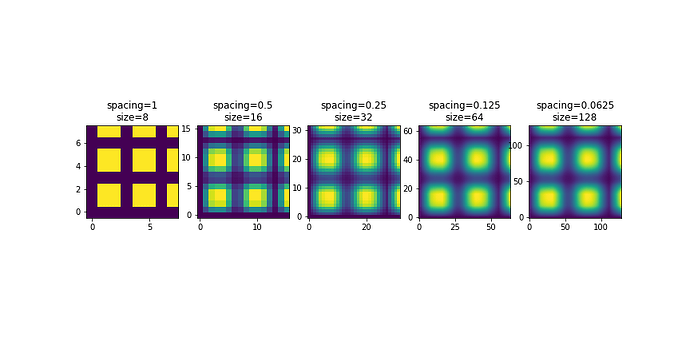Hi there,
I’m running into an issue when upsampling an image with SimpleITK. I’ve created a simple grid to test my upsampling code, and my SimpleITK implementation seems to introduce some shift. Any ideas what I’m doing wrong? I’ve attached a reference (scipy) implementation and my SimpleITK version below.
Scipy
import numpy as np
import scipy
# Create data.
spacing = 1
data = np.array([
[0., 0., 0., 0., 0., 0., 0., 0.],
[0., 1., 1., 0., 1., 1., 0., 1.],
[0., 1., 1., 0., 1., 1., 0., 1.],
[0., 0., 0., 0., 0., 0., 0., 0.],
[0., 1., 1., 0., 1., 1., 0., 1.],
[0., 1., 1., 0., 1., 1., 0., 1.],
[0., 0., 0., 0., 0., 0., 0., 0.],
[0., 1., 1., 0., 1., 1., 0., 1.]])
# Upsample.
def resample(data, spacing, output_spacing):
scale = spacing / output_spacing
resampled = scipy.ndimage.zoom(data, scale, order=1)
return resampled
n_upsample = 5
_, axs = plt.subplots(1, n_upsample, figsize=(12, 6))
for ax in axs:
ax.set_title(f"spacing={spacing}\nsize={data.shape[0]}")
ax.imshow(np.transpose(data), origin='lower')
output_spacing = spacing / 2
data = resample(data, spacing, output_spacing)
spacing = output_spacing
Output:
SimpleITK
import matplotlib.pyplot as plt
import numpy as np
import SimpleITK as sitk
# Create data.
spacing = (1, 1, 1)
data = np.array([
[0., 0., 0., 0., 0., 0., 0., 0.],
[0., 1., 1., 0., 1., 1., 0., 1.],
[0., 1., 1., 0., 1., 1., 0., 1.],
[0., 0., 0., 0., 0., 0., 0., 0.],
[0., 1., 1., 0., 1., 1., 0., 1.],
[0., 1., 1., 0., 1., 1., 0., 1.],
[0., 0., 0., 0., 0., 0., 0., 0.],
[0., 1., 1., 0., 1., 1., 0., 1.]])
# Upsample.
def resample(data, spacing, output_spacing):
image = sitk.GetImageFromArray(data)
image.SetSpacing(spacing)
size = image.GetSize()
size_scaling = np.array(spacing) / np.array(output_spacing)
output_size = tuple(int(s * sc) for s, sc in zip(size, size_scaling))
output_origin = image.GetOrigin()
resampled = sitk.Resample(
image,
output_size,
outputOrigin=output_origin,
outputSpacing=output_spacing,
)
return sitk.GetArrayFromImage(resampled)
n_upsample = 5
_, axs = plt.subplots(1, n_upsample, figsize=(12, 6))
for ax in axs:
ax.set_title(f"spacing={spacing[0]}\nsize={data.shape[0]}")
ax.imshow(np.transpose(data), origin='lower')
output_spacing = tuple(np.array(spacing) / 2)
data = resample(data, spacing, output_spacing)
spacing = output_spacing
Output:
Thanks,
Brett



